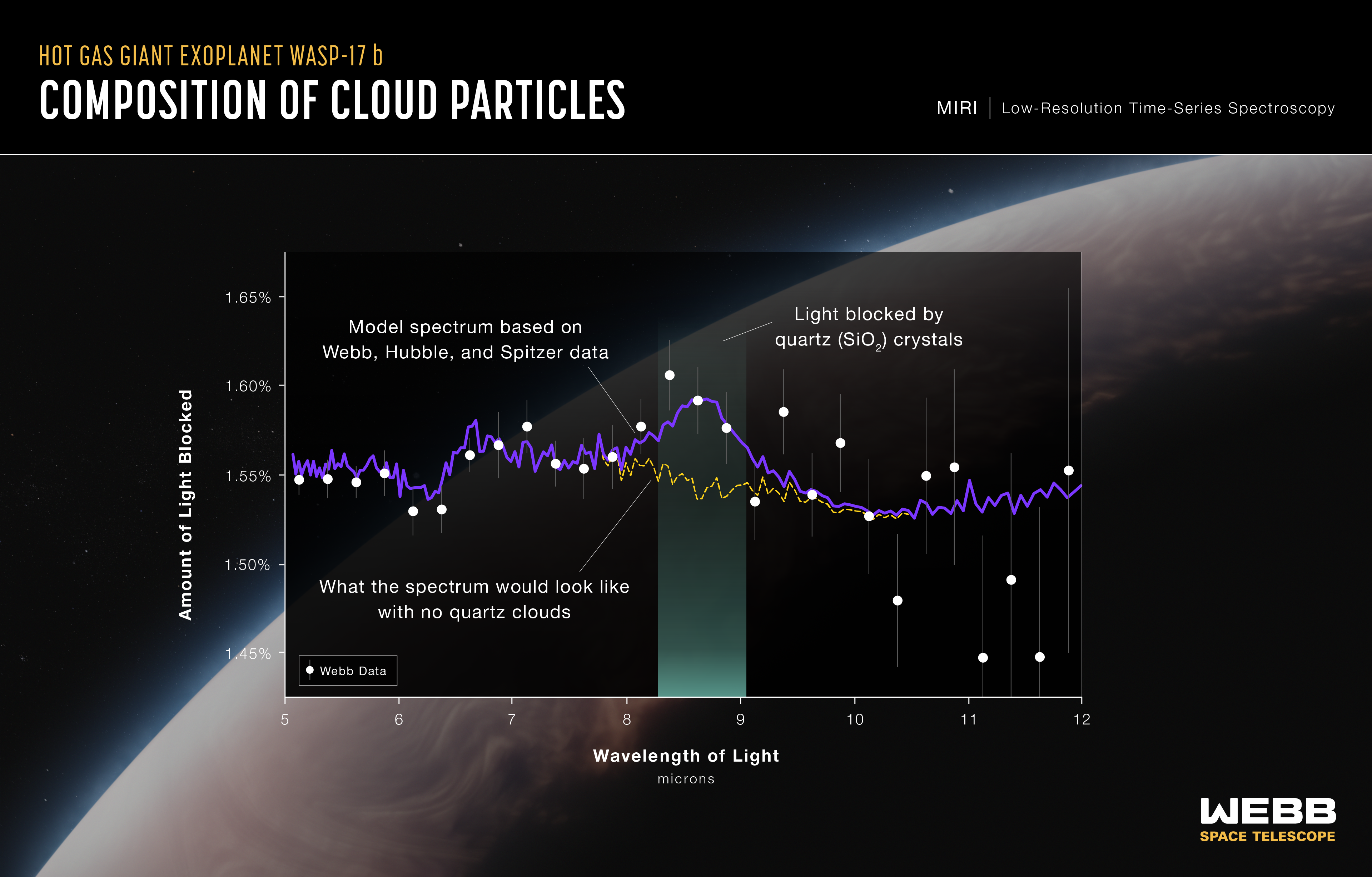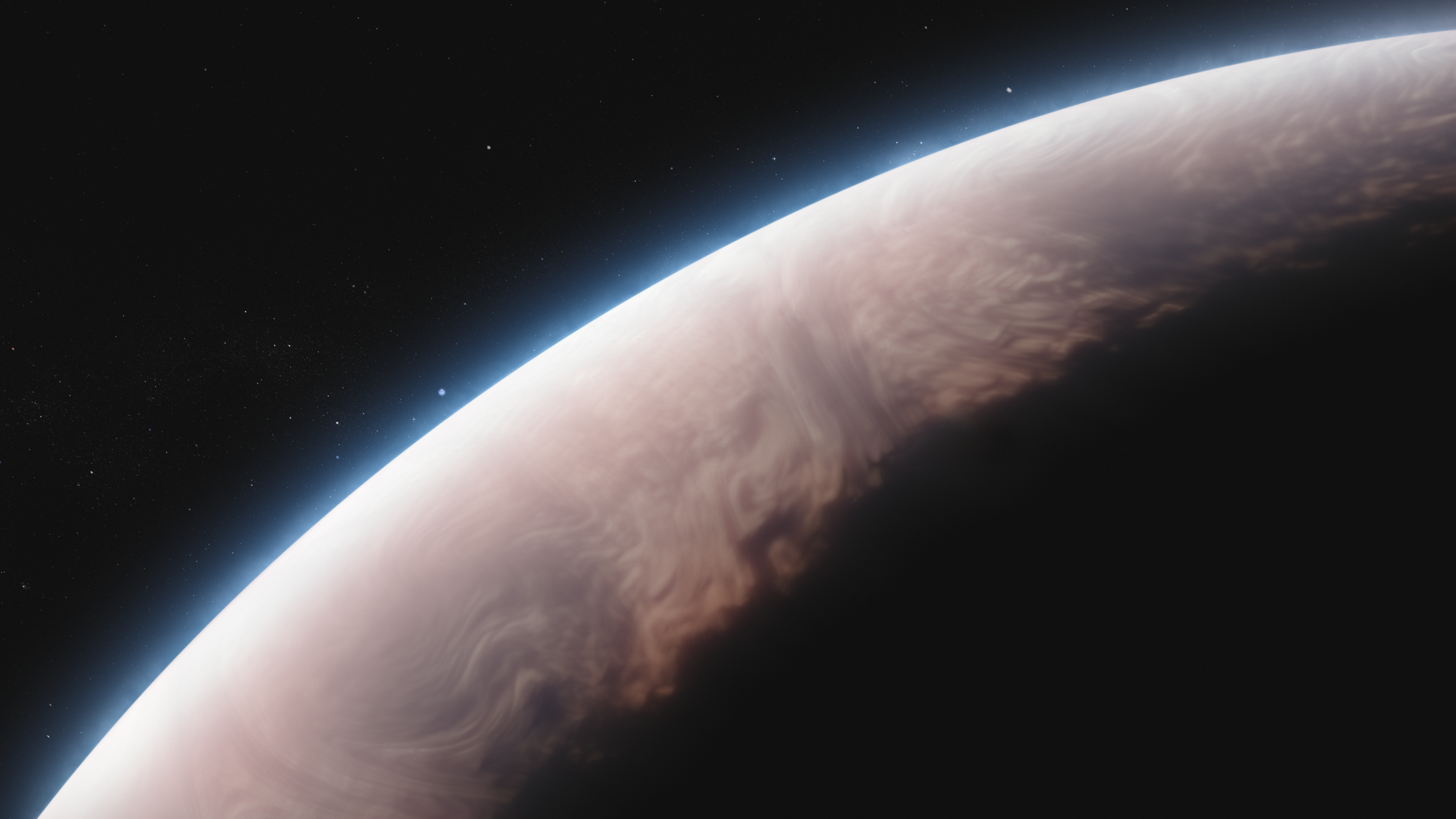1 min read
Exoplanet WASP-17 b (MIRI Transmission Spectrum)

A transmission spectrum of the hot gas giant exoplanet WASP-17 b captured by MIRI (Webb’s Mid-Infrared Instrument) on March 12-13, 2023, reveals the first evidence for quartz (crystalline silica, SiO2) in the clouds of an exoplanet.
The spectrum was made by measuring the change in brightness of 28 wavelength-bands of mid-infrared light as the planet transited its star. Webb observed the WASP-17 system using MIRI’s low-resolution spectrograph for nearly 10 hours, collecting more than 1,275 measurements before, during, and after the transit.
For each wavelength, the amount of light blocked by the planet’s atmosphere (white circles) was calculated by subtracting the amount that made it through the atmosphere from the amount originally emitted by the star.
The solid purple line is a best-fit model to the Webb (MIRI), Hubble, and Spitzer data. (The Hubble and Spitzer data cover wavelengths from 0.34 to 4.5 microns and are not shown on the graph.) The spectrum shows a clear feature around 8.6 microns, which astronomers think is caused by silica particles absorbing some of the starlight passing through the atmosphere.
The dashed yellow line shows what that part of the transmission spectrum would look like if the clouds in WASP-17 b’s atmosphere did not contain SiO2.
This marks the first time that SiO2 has been identified in an exoplanet, and the first time any specific cloud species has been identified in a transiting exoplanet.
About the Object
- R.A. PositionR.A. PositionRight ascension – analogous to longitude – is one component of an object's position.15h59m50.94s
- Dec. PositionDec. PositionDeclination – analogous to latitude – is one component of an object's position.-28d03m42.46s
- ConstellationConstellationOne of 88 recognized regions of the celestial sphere in which the object appears.Scorpius
- DistanceDistanceThe physical distance from Earth to the astronomical object. Distances within our solar system are usually measured in Astronomical Units (AU). Distances between stars are usually measured in light-years. Interstellar distances can also be measured in parsecs.1,300 light-years (400 parsecs)
- DimensionsDimensionsThe physical size of the object or the apparent angle it subtends on the sky.Diameter: 1.9 × Jupiter; Mass: 0.48 × Jupiter
About the Data
- Data DescriptionData DescriptionProposal: A description of the observations, their scientific justification, and the links to the data available in the science archive.
Science Team: The astronomers who planned the observations and analyzed the data. "PI" refers to the Principal Investigator.Low-resolution time-series spectroscopy (5-12 microns)
- InstrumentInstrumentThe science instrument used to produce the data.MIRI
- Exposure DatesExposure DatesThe date(s) that the telescope made its observations and the total exposure time.March 12-13, 2023
- Object NameObject NameA name or catalog number that astronomers use to identify an astronomical object.WASP-17 b (also called Ditsö̀)
- Object DescriptionObject DescriptionThe type of astronomical object.Hot Jupiter Exoplanet
- Release DateOctober 16, 2023
- Science ReleaseWebb Detects Tiny Quartz Crystals in the Clouds of a Hot Gas Giant
- CreditIllustration: NASA, ESA, CSA, Ralf Crawford (STScI); Science: David Grant (University of Bristol), Hannah Wakeford (University of Bristol), Nikole Lewis (Cornell University)
Related Images & Videos

Exoplanet WASP-17 b (Artist's Concept)
This artist's concept shows what the exoplanet WASP-17 b could look like. WASP-17 b, also called Ditsö̀, is a hot gas giant that orbits its star at a distance of just 0.051 AU (about 4.75 million miles, or one-eighth the distance between Mercury and the Sun), completing one full...
Share
Details
Laura Betz
NASA’s Goddard Space Flight Center
Greenbelt, Maryland
laura.e.betz@nasa.gov
NASA, ESA, CSA, Ralf Crawford (STScI)
David Grant (University of Bristol), Hannah Wakeford (University of Bristol), Nikole Lewis (Cornell University)






























